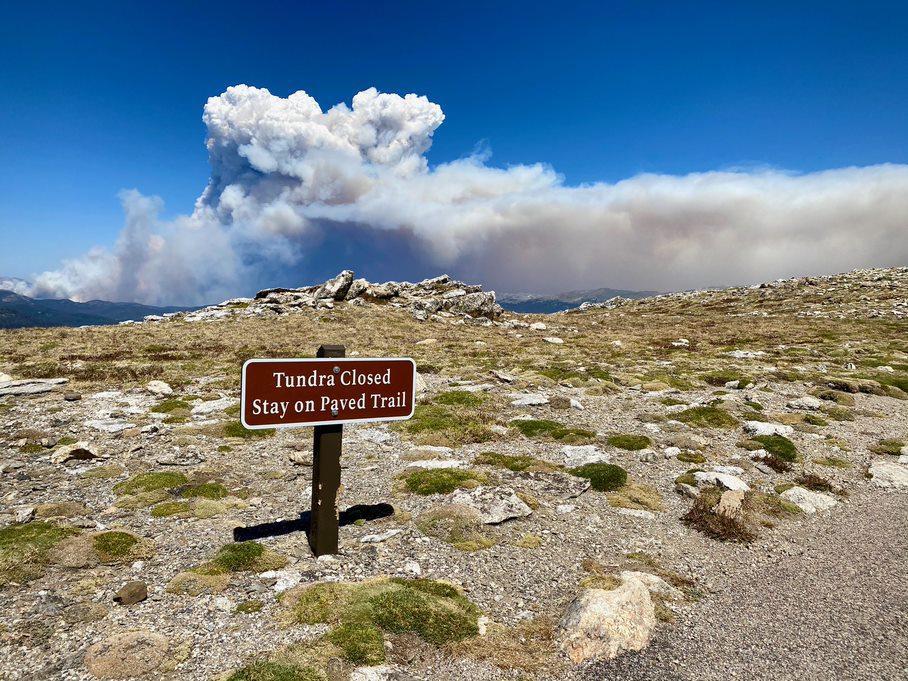There’s a Fire Burning in Rocky Mountain National Park—and It’s Not the Only Wild Area in Danger

'Inciweb'
Update, 10/22/20: Rocky Mountain National Park has completely closed to visitors due to another nearby fire, the East Troublesome Fire, burning on the west side of the park. The blaze, which began on October 14, has burned 125,602 acres so far and is just 5% contained. The National Park Service announced a more limited closure, covering just the west side of the park, the previous day. Earlier this week, the Forest Service announced the total closure of national forests across five counties in northern Colorado through November 15 due to extreme fire danger.
Update, 9/7/20: The Cameron Peak Fire has crossed into Rocky Mountain National Park. On Sunday, September 6, park officials announced the closure of Trail Ridge Road, a popular high-altitude route that traverses the park, due to heavy smoke and poor visibility from the blaze burning in the park’s far northwestern reaches. As of September 7, the Cameron Peak fire has grown to just over 89 thousand acres and is just 4% contained.
Original Post: Since a rash of wildfires broke out across the western US this month, flames have forced evacuations, destroyed a state park, and closed an interstate for weeks. Now, with a fire just miles from its border, one of America’s most popular national parks has begun to close trails.
On Tuesday, Rocky Mountain National Park announced it would shut off access to a remote northwestern swath of the park due to the nearby Cameron Peak Fire. As of the time of writing, the closures include a dozen trails, several cross-country travel zones, and 20 wilderness campsites, but no park roads.
First reported on August 13, the Cameron Peak Fire has grown to cover more than 16,000 acres of forest, spreading quickly in hot and dry conditions. Currently, the fire is about four miles from the park’s northwest boundary, though that number includes burns intentionally set by firefighters, and is 0% contained. While the blaze hasn’t caused any injuries, the National Guard rescued one backpacker who was trapped by the flames after he called for help on a satellite beacon.
Wildfires have run rampant across the western United States this summer, fueled in part by a changing climate. There are at least 86 large fires burning across the country right now, according to The National Interagency Fire Center. The entire state of Colorado is in drought, complicating efforts to extinguish four major fires burning across the state. In California, 26 large blazes have forced thousands to evacuate and killed at least 5 people.
For people living in arid western states, researchers say, these fires are a glimpse of the future. In a paper published last year in the journal Earth’s Future, researchers from Columbia, the University of Idaho, and three other US institutions found that the area consumed annually by wildfires in California had grown by nearly 500% since the 1970s.
“Human‐caused warming has already significantly enhanced wildfire activity in California, particularly in the forests of the Sierra Nevada and North Coast, and will likely continue to do so in the coming decades,” they wrote.
This year’s fires have already impacted at least one natural landmark, torching historic buildings and trees in California’s Big Basin State Park, the oldest in the state. Two journalists from San Francisco’s Mercury News visited the area in the aftermath of the fires and found that nearly all of the park’s redwoods had been scorched, some fatally.
Hikers should take precautions when venturing into national parks and forests, especially when there is a fire watch or warning in the area. With the dry, hot and windy weather, it is important to take extra care when lighting fires, even in permitted locations. (Colorado has issued a statewide, 30-day fire ban.) Smoke can also pose a threat to hikers, even in areas not directly impacted by a wildfire.